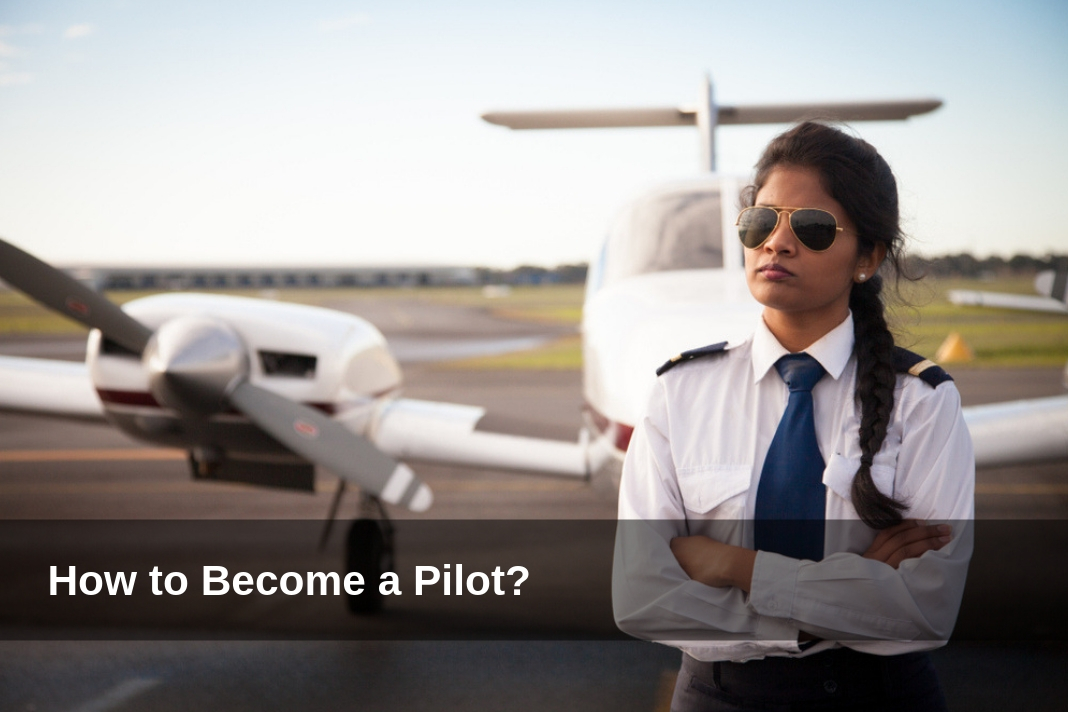
Commercial pilots are recruited for flying aircraft. They are trained to fly charter flights, crop dusters, emergency planes, and for rescue operations, apart from scheduled flights. The career comprises of a very critical job duty. Balancing a flying object in mid-air with hundreds of people’s lives relying on you is not an easy feat. And, therefore one must be mentally and physically prepared to pursue a career as a pilot.
You need years of education, training, and licensure to become a pilot. You need to start early in this career so that you have at least a tenure of 10 years to be credited as a best-flying, and high-earning pilot. In this blog, we will tell you the things required and the steps to follow to become a successful pilot.
Step 1: Get a Degree
Finish your high school at least to get into aviation. You should have a high school diploma or earn a General Education Development certificate. For more (and best) information, contact your local aviation schools or flight instructors and find the policies in your country. However, some flight instruction schools offer courses to students as young as 16 years old. So, cross check before you proceed.
You may also need to complete your bachelor’s degree in aviation or aeronautics if your state requires for it. Although this is not compulsory, most employers today prefer their applicants to have completed 4 years of college education. You can also pursue physics, chemistry, and mathematics.
Here is a tip: consider joining the military if you want to learn from the experts and secure a great position in the very beginning itself. You will not only receive flying lessons but also gain required flying hours. You must be at least be18 to join the army. Once you are trained, you can return to your civilian life.
Step 2: Take Separate Flight Training Classes
Most aviation schools and colleges in the US do have flight training classes. However, if you did not pursue an aviation degree, you will be needed to take flight classes from a Federal Aviation Administration (FAA) certified instructor. You must need sufficient flying training, especially cross-country flight solo before you apply for a license. FAA has mandated this. Unless you pass their test, you won’t be awarded a license.
Step 3: Join a Flight School
Based on your interest and passion, you can choose between two main flight schools in the US, namely Part 61 Training and Part 141 Training. Part 61 is easy and commonly preferred by all. Instructors will train you according to your personal needs, it is flexible, and you will learn everything at a slower pace.
On the other hand, Part 141 Training is strict and comprehensive. The system is more structured where the lessons plan detail and rigorous, and everything goes at a fast pace.
Step 4: Getting Your License and Certificates
In order to become a commercial pilot, you will need to obtain several licenses and certificates, as well as ratings. So, here is a list of things you need to do to get your commercial license:
Medical Certificate
The first thing that you need to obtain is an up-to-date first or second-class medical certificate. You have to pass a physical examination. An Aviation Medical Examiner will verify if you meet the health and fitness requirements to become a pilot. This examination includes several parts. The first part would be applying online and answering basic questions, such as medical history and demographics.
And then, you have to visit a doctor who will validate your physical and mental health, right from height and weight, to any vital illnesses or diseases. There are different classes of medical examination and each class is for different pilot jobs.
- First class medical examination: It is mandatory for future an airline pilot job
- Second Class Medical Examination: It is required to become a commercial pilot
- Third Class Medical Examination: It is restricted to only student or private pilot licensure
A physical examination is compulsory to get into this career. You can treat your ailment and fix it before you get your medical check-up done. However, you will be put into restriction based on what ailment you have. Once you become a captain, you will have to go through a physical examination every 6 months. Other commercial pilots need to clear the test once in a year.
Get Your Student or Private Pilot License
You will qualify for a private or student pilot license after you get your medical certificate. However, this is not all. A Student Pilot License is restricted. You can fly on your own in restrictive zones or with your instructor, while you work towards acquiring your full licensure. With a student license, you cannot expect to earn money. It acts just like a school ID card that gives you permission to fly.
You should be fluent in the English language so that you are able to communicate via radio.
Start Flying to Gain Hours
Gain at least 250 hours of flight time to earn a commercial pilot license. This is regulated by the FAA and you will be flying under an FAA certified examiner or trainer. You can also earn these hours by joining a flight school or military.
Pass the Flying Examination
The commercial pilot license will allow you to receive payments for your flight services. This is a lot like earning a driving license after passing a driving test. After you have completed your 250 hours of flight time, an FAA certified examiner would check your skill by asking you to plan a flight, quiz you on aviation subject and then join a flight with you to test your reflexes, maneuvers, and control. Throughout the flight, you will be asked to direct the plane to different directions using various controls. If everything goes well, at the end of the examination, you will be given a Commercial Pilot’s License.
However, to qualify for a pilot job in commercial airlines, you will need additional flying hours. You can earn those extra hours by becoming a flight instructor.
Airline Transport Pilot Certificate
Most commercial pilots also get an additional airline transport pilot certificate. An Airline Transport Pilot Certificate is the highest pilot license that makes you eligible to be the pilot in command or captain of commercial aircraft, especially large flights that fly across the world. However, getting this license is not an easy task. To qualify as an Airline Transport Pilot, you must have the following:
- Be a high-school graduate
- Receive a first-class medical certificate
- Pass a written test and
- Have at least 1,500 flight hours, including a 250-hour journey as a captain or pilot in command
Depending upon what you want you can apply for and obtain further certifications, such as multi-engine plane certification and flight instructor certification.
Today most commercial airlines pilot fly multi-engine flights. Therefore, all you have to do is take some simple lessons and a multi-engine check ride to get the certificate.
You may also need to obtain an Instrument Rating certificate to fly in bad weather and in clouds (low visibility). In order to get this certificate, you need to pass instrument ground test, earn a specific number of Instrument Flight Hours (flying in low visibility), and clear an Instrument Rating check-ride through an FAA certified trainer.
Step 5: Job Opportunities and Career Paths
You can apply for a broad variety of jobs with all those certifications mentioned above. You can work for emergency services, air shows, in military, firefighting and forestry organizations, or as a flight instructor. However, the career paths are broadly classified into two: Military and Civilian.
Military:
To gain eligibility to work in the military as a commercial pilot, you train with the military. However, after the initial year of pilot training, you will need to commit a certain number of years in the defense. However, if you are looking for a career in Airforce, this commitment will extend to 10 years. You may also have to go through other rigorous training, in terms of education and physical fitness. You must have good health and physical endurance to qualify in the military.
However, there is no guarantee of what your position would be and what you would fly. You cannot take this career path lightly and must stay focused and determined at all levels. You may or may not pass the military flight training on the service’s rigid time schedule. There is no guaranteeing that you will be allowed to fly a specific airplane either. Your commitment and your performance will define your job role and future. You will be definitely required to follow orders, use lethal weapons, and may face injuries. However, the only assurance is that you will receive training from best instructors and with the best equipment.
There are over 150 careers available in the US Air Force, let alone the entire world.
Civilian:
In order to be a civilian pilot, you can choose between two options: College and Flight School. We have mentioned everything about college, such as what degree you can pursue, how to get into college, where to get the training etc. Although a college degree is not compulsory, it shows that you are fit to be trained and that you can pass through a challenging curriculum. Facing challenges and the zeal to learn, both are required to achieve success as a commercial airline pilot.
Civilian flight training could be expensive and may not be available everywhere. Basically, it is an individual training session where you have to rent your airplane and pay for the instructions. You will have to complete the mandated 250 hours flight time, which may become costly, for basic flying lessons in the US starts from $80 an hour.
Before you apply for a job, go through the qualifications needed, especially the number of hours in flight time and experience. You can also get into Aviation engineering. Some pilots also take engineering with airlines. For this, you will have to gain relevant knowledge and study engineering in UG. Additionally, you will have to get training and apply for a separate engineering license to work with airlines.
What Happens Next?
After you are certified, you will further require more flight hours and experience before a commercial airline hires you. For instance, you will typically require 3000 hours of total flight time, including 1000 hours of Pilot in Command (PIC) in jet-powered aircraft, in type aircraft, or scheduled airline. Depending upon the airline, these numbers will decrease or increase.
You will also be required to pass a psychological and intelligence examinations before you are qualified. Your start your career as a first officer or flight engineer in regional airlines, where you will gain experience in flying passengers in different weather conditions. Depending upon the company, you may also get training for flight engineer if you do not own the degree. You must have an airline transport pilot license to qualify as a First Officer or Captain. Companies other than airlines also hire pilots with lesser flying experience. Flying regionally often leads to bigger jobs, such as working with national and major airlines.
Your level of experience will not only be based upon the number of flight hours but also on the number and complexity of aircrafts you have flown, your past positions in the crew, and the complexity of flying, including day or night, local or cross country, with or without visibility flying, and jet or propeller. With a military career, you will more likely have enough experience in terms of flying hours and complexity before you resign the military to become a commercial airline pilot.
However, if you want to go steady and upwards, start as a flying instructor, then move in a charter company and gain experience, and then finally apply for commercial airline pilot position.
Depending upon your seniority, you will advance in your career. For instance, with 1 – 5 years’ experience, you can qualify as the first officer, and with 5 – 15-years experience, you can advance to become a captain. After captainship, you will be qualified to become chief pilot and director of aviation.
Hope this article helps to clear all your doubts and makes your decisions making easier. All the best.




